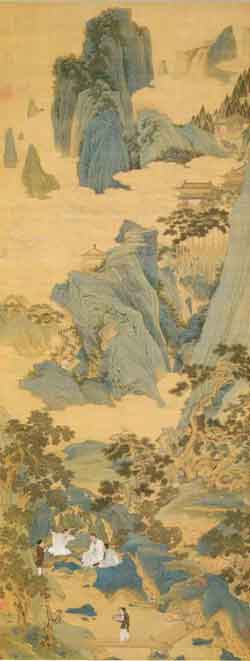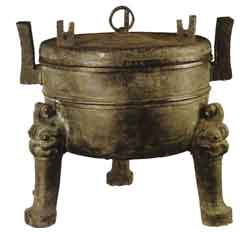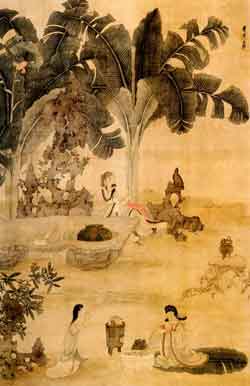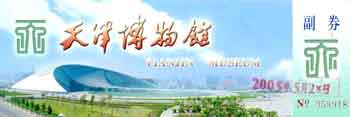|
|||||||||
|
ARTICLESMUSEUM REPORTS:TIANJIN MUSEUM (Tianjin Bowuguan)  Illustration 1. External view of new Tianjin Museum
from elevated position.
Illustration 1. External view of new Tianjin Museum
from elevated position.
The massive new Tianjin Museum, which opened in December 2004, is said to be China's second largest building. Although it consists of only three above-ground levels, these are enclosed under a giant shell walled on one side by glass. Constructed by Shin Takamatsu Architect and Associates, the new museum was designed by Japanese architect Mamoru Kawaguchi, best known the Yoyogi Olympic Gymnasium and Nara Convention Hall. The shell-shaped structure of the building resembles a swan emerging from an egg, yet by day the building is strangely devoid of character, resembling either a sports facility or an airport terminal huddling at the edge of a dauntingly vast and unrelieved flat lawn. Illuminated at night, however, the building is magnificent (see Illustration 2).  Illustration 2. View of Tianjin Museum illuminated at night
Illustration 2. View of Tianjin Museum illuminated at night
With a floor space of 31,400 sq m, the new museum houses impressive collections of the former Tianjin Art Museum and the Tianjin Historical Museum - venues now more than half a century old that have outlived their usefulness. The new museum boasts a total of 150,000 objects. The halls accommodating the exhibits cover two floors of the new three-storey building, with the ground floor, covering 10,000 square metres, comprising a coffee shop and visitors' concourse, as well as a closed off area with storage facilities, offices and a reading room. From the glass-shrouded hall on the ground floor, one ascends by elevator to the second floor where an exhibition titled A Century of Acquisitions: Exhibition of Treasures of the Tianjin Museum links with the collections of classical paintings, calligraphy, ceramics, and inkstones from the former Tianjin Art Museum and the Tianjin Historical Museum. The top floor is devoted to an exhibition hall presenting the history of Tianjin over the past century, as well as a city planning display. EXHIBITION OF TREASURES OF THE TIANJIN MUSEUMThis special exhibition arranged for the opening of the museum comprises 106 pieces, of which more than 90 are classified as Grade One National Treasures, the highest category of "cultural relic". The exhibits are intended to emphasise the contribution of Tianjin's collectors and museum donors to the preservation of China's cultural tradition over the past century. Many valuable items from the Imperial collections of Beijing and Chengde (the Qing imperial hunting villa) found their way to Tianjin, brought by the Xuantong Emperor Pu Yi (Henry Aisingioro Puyi) and other members of the royal family in the early Republican period after they fled Beijing, as well as by flunkeys and other palace pilferers. These valuable items often ended up in the flourishing antique shops located in the Japanese Concession area of Tianjin in the 1920s and 1930s. 
Ming dynasty  Warring States
Warring StatesChu Wang ding (Bronze tripod of King of Chu) Overall height: 53 cm Diameter at mouth: 45.5 cm Diameter at belly: 148 cm CALLIGRAPHYThe Tianjin Museum has a large and excellent collection of calligraphy, and rubbings of stone inscriptions. Of these, a judicious selection of 193 works, emphasising the intertwined development of the Chinese language and this art, are on display. The hall includes works ranging in time from oracle bones and inscriptions on stone to works on silk and paper, making clear the various media that the calligrapher's art encompasses. Works by almost all the major figures in the history of calligraphy are held by the museum, and pieces by such masters as Chu Suiliang, Ouyang Xiu, Yan Zhenqing, Yang Weizhen, Su Shi, Mi Fei, Zhao Mengfu, Zhu Yunming, Wen Zhengming, Xu Wei, Zheng Xie (see illustration) and Wu Changshuo are all on display.  Qing dynasty
Qing dynastyZheng Xie Xingshu style work on paper Height: 105.8 cm Width: 63.5 cm CERAMIC ARTSThe Ceramics Exhibit focuses on the various techniques used to decorate ceramics. Covering 750 sq m, the ceramics hall displays more than 260 pieces from the collection. As well as impressive blue-and-white pieces, one of the most interesting displays is a range of exquisitely coloured monochrome wares of the Qing dynasty, juxtaposed with other striking glazes such as the Song dynasty francolin partridge glaze and rabbit's fur glaze. Among these unusual glazes is that on a large Yongzheng period Qing zun vase with ruyi handles and tea leaf dust glaze, standing nearly a metre high, which creates the effect of suede leather straps attached to metal buckles. Many of the pieces are unique, for example the Ming wucai ("five-colour") lidded jar shown below is one of only two known examples of its type, demonstrating the blue-and-white wucai artistry of the Ming-Qing transitional period.  Ming dynasty
Ming dynastyJiajing period Lidded wucai jar with reign mark and design of fish among aquatic plants Height: 46 cm Diameter at mouth: 20 cm Diameter at foot: 24.6 cm CLASSICAL PAINTINGThe Tianjin Museum has one of China's finest collections of classical paintings. For the time being, the museum is displaying its Song and Yuan dynasty paintings in the "Treasures" exhibit, while the classical painting hall focuses on Ming and Qing works, with most prominent artists of the period represented among the nearly 200 pieces on display.  Ming dynasty
Ming dynastyChen Hongshou Jiaolin zhuojiu tu (Imbibing wine in the plantain grove) (detail) Colour ink on vertical silk scroll Height: 156.2 cm Width: 107 cm INKSTONESThe Tianjin Museum is also famed for its collection of inkstones, having some of the only known examples of Song dynasty inkstones made of chengni, a low temperature fired pressed clay ceramic, inscribed and made by master craftsmen from Guozhou. Nearly one hundred examples of Tang, Song, Yuan, Ming and Qing dynasty inkstones are featured, but most displayed items are from the Ming and Qing dynasties. The clean lines of the inkstones are uncannily complemented by the architecture of the museum itself.  Qing dynasty
Qing dynastyInkstone of Duan stone inscribed with inscription from Lanting xu (Preface of Orchid Pavilion) Length: 18.6 cm Width: 11.1 cm Height: 6.8 cm ONE HUNDRED YEARS OF TIANJINThis large exhibition focuses on the history of Tianjin as a treaty port, a city of foreign concessions and a centre of revolution in the 20th century. Exhibits document the rise of Tianjin as an industrial, trading and commercial city. Old photographs are enlivened by tableaux and replicas of a tram carriage, a locomotive and many of the appurtenances and enterprises of the modern metropolis. A life-size model of the retail department of Keyserling's cake shop takes its side beside old printing presses and revolutionary handbills. ConclusionThe management of the Tianjin Museum does not allow visitors to take photographs, at variance with the practice of most new museums in China and elsewhere. Moreover, there is no English labelling at present which detracts from the value of the collections for foreign visitors unfamiliar with Chinese. Headsets with limited English commentary are available for hire. [BGD] 
Contact |